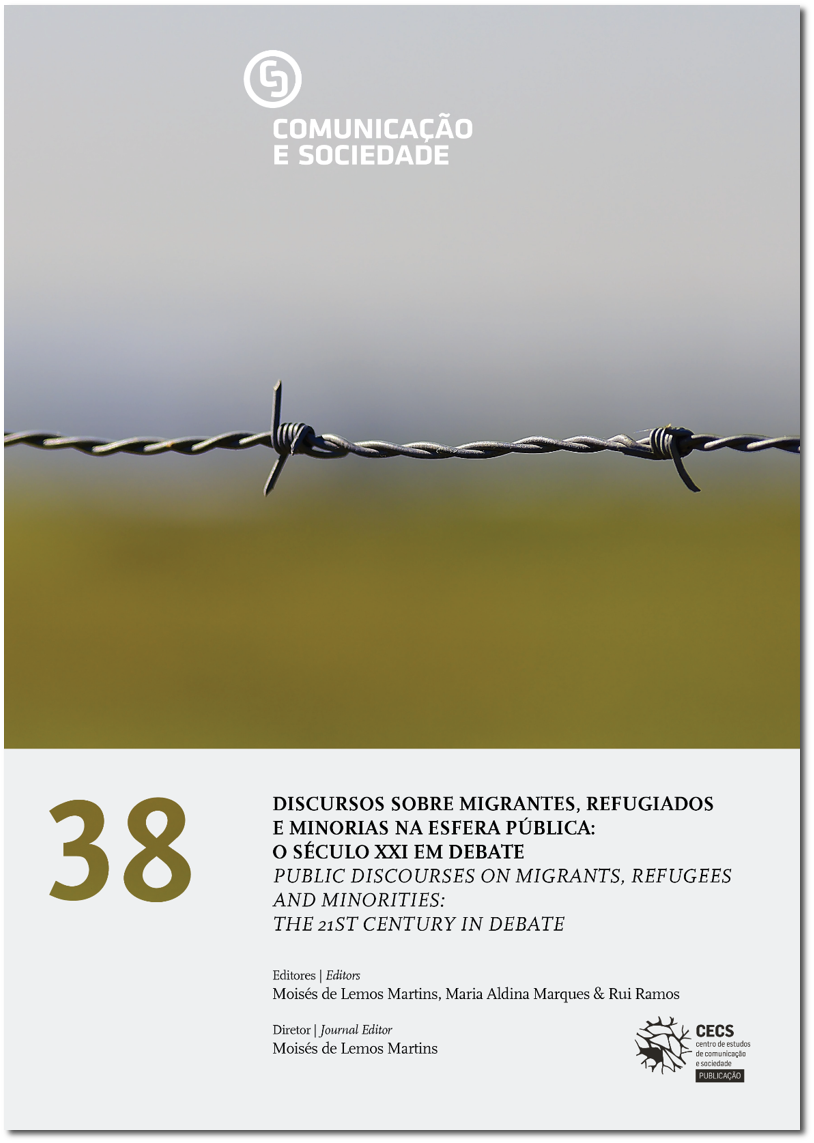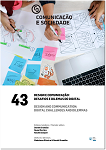Being present through absence: the semiotic construction of recent Brazilian migration to Portugal in the Brazilian media
DOI:
https://doi.org/10.17231/comsoc.38(2020).2592Keywords:
media discourse, migrations, social semiotic, intersectionality, Portugal pelos BrasileirosAbstract
Over recent years, a rising number of Brazilians have migrated to Portugal. This phenomenon confirms certain trends that have already been identified in the literature while also revealing important changes in its configuration. These transformations are accompanied by a diversification of discourses about the phenomenon, that occurs across different media platforms. In the case of television, the discourses are transmitted in the form of audiovisual content which, more than just being an alternative language to writing, constitutes an important tool for articulating knowledge. In an attempt to understand the semiotic approach towards this fact in the Brazilian media, we decided to analyse all episodes from the first season of the television journalistic series, Portugal pelos Brasileiros (Portugal by Brazilians), broadcast in Brazil by Rede Globo de Televisão in early 2018. The principles of Social Semiotics developed by Gunther Kress and Theo van Leeuwen were used from an intersectional perspective as a starting point to unveil how the visual and sound resources used in this series, and the combination thereof, contribute to the construction of discourses about new Brazilian immigrants living in Portugal. In view of the identified arrangements, we conclude that we are facing a media discourse that privileges representation of recent Brazilian immigration in Portugal in a segmented manner, revealing the perspective of one specific group of immigrants, to the detriment of the plurality of voices and experiences that are inherent to the phenomenon as a whole. We view the ongoing intention to separate the representations of the new Brazilian immigrants in Portugal from other representations commonly related to Brazilian migrants from previous migratory waves, through the configuration of new semiotic repertoires to the effect, as a part of broader discursive strategies that might have direct consequences on the social life of the persons in question.
Downloads
References
Araújo, E., Cogo, D. & Pinto, M. (2015). Mobilidades, media(ções) e cultura. Comunicação e Sociedade, 28, 7-14. https://doi.org/10.17231/comsoc.28(2015).2267
Assis, G. de O. (2017). Trânsitos contemporâneos: o ir e vir de emigrantes brasileiros(as) rumo à Europa. Terceiro Milênio: Revista Crítica de Sociologia e Política, 8(1), 210–229. Retirado de http://www.revistaterceiromilenio.uenf.br/index.php/rtm/article/download/10/11
Assis, G. de O., Silva, L. M. da & Frederico, M. S. (2016, junho). Mídia e migração: uma análise da (in)visibilidade dos migrantes brasileiros na Europa. Comunicação apresentada no 6° Encontro Regional Sul de História da Mídia, Ponta Grossa.
Bastia, T. (2014). Intersectionality, migration and development. Progress in Development Studies, 14(3), 237-248. https://doi.org/10.1177/1464993414521330
Bourdieu, P. (1997). Sobre a televisão. Oeiras: Celta Editora.
Bourdieu, P. (1998). Prefácio: um analista do inconsciente. In A. Sayad (Ed.), A imigração ou os paradoxos da alteridade (pp. 9-12). São Paulo: EdUSP.
Crenshaw, K. (1991). Mapping the margins: intersectionality, identity politics, and violence against women of color. Stanford Law Review, 43(6), 1241-1299. https://doi.org/10.2307/1229039
Fairclough, N. (1995). Media discourse. Londres: Hodder Headline Group.
Fiske, J. & Hartley, J. (1978/2003). Reading television. Londres: Routledge.
Fonseca, M. L., Esteves, A. & Iorio, J. (2015). Mobilidade internacional de estudantes do ensino superior. In J. Peixoto, B. Padilla, J. C. Marques & P. Góis (Eds.), Vagas atlânticas: migrações entre Brasil e Portugal no início do século XXI (pp. 135-158). Lisboa: Mundos Sociais.
França, T. & Padilla, B. (2018). Imigração brasileira para Portugal: entre o surgimento e a construção mediática de uma nova vaga. Cadernos de Estudos Sociais, 33(2), 207-237.
Gervereau, L. (2007). Ver, compreender, analisar as imagens. Lisboa: Edições 70.
Hall, S. (1973/2001). Encoding and decoding in the television discourse. In S. During (Ed.), The Cultural Studies reader (pp. 507-517). Londres: Routledge.
Heller, E. (2012). A Psicologia das cores: como as cores afetam a emoção e a razão. São Paulo: Gustavo Gili.
Iedema, R. (2004). Analysing film and television: a social semiotic account of “hospital: an unhealthy business”. In T. van Leeuwen & C. Jewitt (Eds.), Handbook of visual analysis (pp. 183-206). Londres: SAGE Publications.
IBGE, Instituto Brasileiro de Estatística e Geografia. (2016). Pesquisa nacional por amostra de domicílios: síntese de indicadores: 2015. Rio de Janeiro: IBGE. Retirado de https://www.biblioteca.ibge.gov.br/visualizacao/livros/liv98887.pdf
IBGE, Instituto Brasileiro de Estatística e Geografia. (2018). Somos todos iguais? O que dizem as estatísticas. Rio de Janeiro: IBGE. Retirado de https://agenciadenoticias.ibge.gov.br/media/com_mediaibge/arquivos/17eac9b7a875c68c1b2d1a98c80414c9.pdf
IBGE, Instituto Brasileiro de Estatística e Geografia. (2019). Desigualdades sociais por cor ou raça no Brasil. Rio de Janeiro: IBGE. Retirado de https://biblioteca.ibge.gov.br/visualizacao/livros/liv101681_informativo.pdf
Iorio, J. C. & Souza, E. J. (2018). A construção midiática do “Eldorado” lusitano a partir dos novos fluxos migratórios de brasileiros para Portugal. Revista de Ciências Sociais, 8(1), 312-340. Retirado de https://periodicos.ufsm.br/seculoxxi/article/view/35676
Kress, G. & van Leeuwen, T. (2001). Multimodal: the modes and media of contemporary communication discourse. Londres: Arnold.
Kress, G. & van Leeuwen, T. (2006). Reading images: the grammar of visual design. Londres: Routledge.
Lima, M. E. O. (2019). O que há de novo no “novo” racismo do Brasil?. Revista Ensaios e Pesquisa em Educação e Cultura, 4(7), 157-177. https://doi.org/10.29327/211303.4.7-10
Lobo, P. & Cabecinhas, R. (2018). Retratos de género nas notícias televisivas: uma análise das desigualdades por detrás da representação numérica. Estudos em Comunicação, 1(26), 81-99. https://doi.org/10.20287/ec.n26.v1.a06
Machado, I. J. de R. (2004). Apontamentos para uma etnografia da imigração brasileira no Porto, Portugal. In Faculdade de Economia da Universidade de Coimbra & Centro de Estudos Sociais (Eds.), A questão social no novo milénio – Livro de Atas do 8° Congresso Luso-Afro-Brasileiro de Ciências Sociais (pp. 1-23). Coimbra: Centro de Estudos Sociais. Retirado de https://dialnet.unirioja.es/servlet/articulo?codigo=4619777
Machin, D. (2013). What is multimodal critical discourse studies? Critical Discourse Studies, 10(4), 347-355. https://doi.org/10.1080/17405904.2013.813770
Marmo, H. (2019, 27 de setembro). Quando o sonho de emigrar para Portugal vira pesadelo. Veja. Retirado de https://veja.abril.com.br/mundo/imigracao-portugal-pesadelo
Martins, M. L. (2017). Crise no castelo da cultura: das estrelas para os ecrãs. Famalicão: Edições Húmus.
May, V. M. (2015). Pursuing intersectionality, unsettling dominant imaginaries. Nova Iorque: Routledge.
Moscovici, S. (1988). Notes towards a description of social representations. European Journal of Social Psychology, 18, 211-250. https://doi.org/10.1002/ejsp.2420180303
Mota-Ribeiro, S. & Pinto-Coelho, Z. (2011). Para além da superfície visual: os anúncios publicitários vistos à luz da semiótica social. Representações e discursos da heterossexualidade e de género. Comunicação e Sociedade, 19, 227-246. https://doi.org/10.17231/comsoc.19(2011).908
Oliveira, F., Cabecinhas, R. & Ferin-Cunha, I. (2011). Retratos da mulher brasileira nas revistas portuguesas. Comunicação apresentada no VII ENECULT - Encontros de Estudos Multidisciplinares em Cultura, Bahia. Retirado de http://hdl.handle.net/1822/19851
Oliveira, M. (2016). O excesso de luz e a fragilização do ouvido. In M. Oliveira & S. Pinto (Eds.), Atas do Congresso Internacional Comunicação e Luz (pp. 329-336). Braga: CECS.
Padilla, B., Marques, J. C., Góis, P. & Peixoto, J. (2015). A imigração brasileira em Portugal: investigação, tendências e perfis. In P. Góis; J. C. Marques; B. Padilla & J. Peixoto (Eds.), Vagas atlânticas: migrações entre Brasil e Portugal no início do século XXI (pp. 9-38). Lisboa: Editora Mundos Sociais.
Pinho, F. (2007). A imprensa na construção do processo migratório: a constituição de Portugal como destino plausível da emigração brasileira. In J. M. Malheiros (Ed.), Imigração brasileira em Portugal (pp. 59-86). Lisboa: Alto Comissariado para a Imigração e Diálogo Intercultural, I.P.
Ribeiro, D. (2017). O que é lugar de fala? Belo Horizonte: Letramento Justificando.
Ribeiro, R. (2018, 18 de agosto). Não era como imaginava: cresce o número de brasileiros que pedem ajuda para voltar de Portugal. UOL Notícias. Retirado de https://noticias.uol.com.br/internacional/ultimas-noticias/2018/08/17/brasileiros-voltam-portugal-emigrar-salario-seguranca-visto.htm
Sayad, A. (2011) La doble ausencia: de las ilusiones del emigrado a los padecimientos del inmigrado. Barcelona: Anthropos Editorial.
SEF, Serviço de Estrangeiros e Fronteiras. (2019). Relatório de imigração, fronteiras e asilo 2018. Oeiras: Serviço de Estrangeiros e Fronteiras. Retirado de https://sefstat.sef.pt/Docs/Rifa2018.pdf
Talbot, M. (2007). Media discourse: representation and interaction. Edimburgo: Edinburgh University Press.
van Leeuwen, T. (1999). Speech, music, sound. Londres: MacMillan.
van Leeuwen, T. (2005). Introducing social semiotics. Londres: Routledge.
Downloads
Published
How to Cite
Issue
Section
License
Copyright (c) 2020 Comunicação e Sociedade

This work is licensed under a Creative Commons Attribution-NonCommercial 4.0 International License.
Authors own the copyright, providing the journal with the right of first publication. The work is licensed under a Creative Commons Attribution 4.0 International License.














